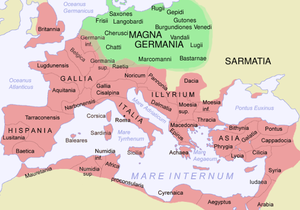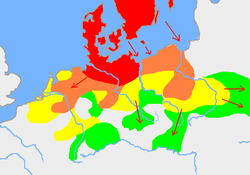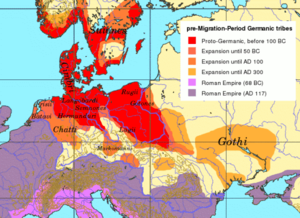Germania: Difference between revisions
Nicknack009 (talk | contribs) avoid disambig page |
m Moved a link |
||
| Line 23: | Line 23: | ||
==See also== |
==See also== |
||
{{wiktionary}} |
{{wiktionary}} |
||
| ⚫ | |||
*[[Germanic Europe]] |
*[[Germanic Europe]] |
||
*[[Germanic peoples]] |
*[[Germanic peoples]] |
||
| Line 46: | Line 47: | ||
[[Category:History of the Netherlands]] |
[[Category:History of the Netherlands]] |
||
[[Category:Prehistory of Poland (until 966)]] |
[[Category:Prehistory of Poland (until 966)]] |
||
| ⚫ | |||
[[ca:Germania (regió)]] |
[[ca:Germania (regió)]] |
||
Revision as of 01:02, 6 June 2007

Germania was the Latin exonym[1][2] for a geographical area of land on the west bank of the Rhine (inner Germania), which extended regions of Sarmatia (modern Poland, Ukraine, Russia), where Slavic tribes dominated.[citation needed] The name was conceived by Romans around 2000 years ago.[3]
History

Germania was inhabited by different tribes, the vast majority Germanic but also including some Celtic, Baltic, Scythian and proto-Slavic. The tribal and ethnic makeup changed over the centuries as a result of assimilation and, most importantly, migrations. The Germanic people spoke several different dialects.
The classical world knew little about the people who inhabited the north of Europe before the 2nd century BC. In the 5th century BC the Greeks were aware of a group they called Celts (Keltoi). Herodotus also mentioned the Scythians, but no other barbarian tribes. At around 320 BC, Pytheas of Massalia sailed around Britain and along the northern coast of Europe, and what he found on his journeys was so unbelievable that later writers refused to believe him. He may have been the first Mediterranean to distinguish the Germanic people from the Celts. Caesar described the cultural differences between the Germanic tribesmen, the Romans and the Gauls. He said that the Gauls, although warlike, could be civilized, but the Germanic tribesmen were far more savage, and were a threat to Roman Gaul, and so had to be conquered. His accounts of barbaric northern tribes could be described as an expression of the superiority of Rome, including Roman Gaul. Caesar's accounts protray the Roman fear of the Germanic tribes and the threat they posed. The perceived menace of the Germanic tribesmen proved accurate. The Romans tried crosssing the Rhine into greater Germania to conquer it only once. This invasion occurred in 9 A.D. resulting in the Battle of the Teutoburg forest which led to the anhilation of tens of thousands of Roman Legionnaires, and one of the Romes greatest defeats. Several hundred years later, it was the mainly Germanic tribes that conquered Rome itself. The most complete account of Germania that has been preserved from Roman times is Tacitus' Germania.

Tacitus wrote in 98 AD:
- "For the rest, they affirm Germania to be a recent word, lately bestowed. For those who first passed the Rhine and expulsed the Gauls, and are now named Tungrians, were then called Germani. And thus by degrees the name of a tribe prevailed, not that of the nation; so that by an appellation at first occasioned by fear and conquest, they afterwards chose to be distinguished, and assuming a name lately invented were universally called Germani."[6]
Regions
Germania was defined by Rome as having two regions: 'the inner Germania', west and south of the Rhine, occupied by the Romans, and 'the big Germania' (Magna Germania) east of the Rhine. The occupied Germania was divided into two provinces: Germania Inferior (approximately corresponding to the southern part of the present-day Low Countries) and Germania Superior (approximately corresponding to present-day Switzerland and Alsace). The Romans under Augustus began to conquer and defeat the Germania Magna in 12 BCE, having the Legati (generals) Germanicus and Tiberius leading the Legions. By 6 CE all of Germania up to the Elbe river was temporarily pacified by the Romans as well as being occupied by them.
See also
External links
- Germania (Roman provinces)
- 1849 Harper New York Map, Ancient Germanic Tribes and Towns
- Tacitus' Germania at the Latin Library (text in Latin)
References
- ^ Stümpel, Gustav. Name und Nationalität der Germanen. Eine neue Untersuchung zu Poseidonios, Caesar und Tacitus (in German). Leipzig: Dieterich. p. 60.
{{cite book}}: Check|first=value (help) - ^ Feist, Sigmund. Germanen und Kelten in der antiken Überlieferung (in German). Baden-Baden.
{{cite book}}: Check|first=value (help) - ^ Tacitus, Germania (book).
- ^ Kinder, Hermann (1988), Penguin Atlas of World History, vol. I, London: Penguin, p. 108, ISBN 0-14-051054-0.
- ^ "Languages of the World: Germanic languages". The New Encyclopædia Britannica. Chicago, IL, United States: Encyclopædia Britannica, Inc. 1993. ISBN 0-85229-571-5.
- ^ Tacitus, Germania 2
Bibliography
- Malcolm Todd (1995). The Early Germans. Blackwell Publishing.
